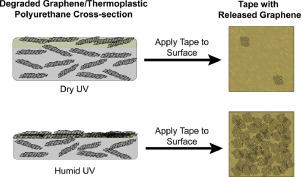Polymer Degradation and Stability ( IF 5.9 ) Pub Date : 2020-09-19 , DOI: 10.1016/j.polymdegradstab.2020.109365 David G Goodwin 1 , Shih-Jia Shen 1 , Yadong Lyu 1 , Ronald Lankone 1 , Ana C Barrios 1, 2 , Samir Kabir 1 , François Perreault 2 , Wendel Wohlleben 3 , Tinh Nguyen 1 , Lipiin Sung 1

|
The ultraviolet (UV)-induced degradation of graphene/polymer nanocomposites was investigated in this study. Specifically, the effect of few-layer graphene nanofillers on the degradation of a thermoplastic polyurethane (TPU) and the release potential of graphene from the degraded nanocomposite surfaces were assessed. Graphene/TPU (G/TPU) nanocomposites and neat TPU were UV-exposed under both dry and humid conditions in the NIST SPHERE, a precisely controlled, high intensity UV-weathering device. Neat TPU and G/TPU were characterized over the time course of UV exposure using color measurements and infrared spectroscopy, for appearance and chemical changes, respectively. Changes in thickness and surface morphology were obtained with scanning electron microscopy. A new fluorescence quenching measurement approach was developed to identify graphene sheets at the nanocomposite surface, which was supported by contact angle measurements. The potential for graphene release from the nanocomposite surface was evaluated using a tape-lift method followed by microscopy of any particles present on the tape. The findings suggest that graphene improves the service life of TPU with respect to UV exposure, but that graphene becomes exposed at the nanocomposite surface over time, which may potentially lead to its release when exposed to small mechanical forces or upon contact with other materials.
中文翻译:

紫外光降解石墨烯/聚合物纳米复合材料:石墨烯纳米填料的作用及其释放潜力
本研究调查了紫外线 (UV) 诱导的石墨烯/聚合物纳米复合材料的降解。具体而言,评估了少层石墨烯纳米填料对热塑性聚氨酯 (TPU) 降解的影响以及石墨烯从降解的纳米复合材料表面释放的潜力。石墨烯/TPU (G/TPU) 纳米复合材料和纯 TPU 在干燥和潮湿条件下在 NIST SPHERE 中进行紫外线照射,NIST SPHERE 是一种精确控制的高强度紫外线老化装置。纯 TPU 和 G/TPU 在紫外线照射的时间过程中使用颜色测量和红外光谱分别表征外观和化学变化。用扫描电子显微镜获得厚度和表面形态的变化。开发了一种新的荧光猝灭测量方法来识别纳米复合材料表面的石墨烯片,并得到接触角测量的支持。使用胶带提升法评估石墨烯从纳米复合材料表面释放的可能性,然后对胶带上存在的任何颗粒进行显微镜检查。研究结果表明,石墨烯可提高 TPU 在紫外线照射方面的使用寿命,但随着时间的推移,石墨烯会暴露在纳米复合材料表面,这可能会导致其在暴露于较小的机械力或与其他材料接触时释放。使用胶带提升法评估石墨烯从纳米复合材料表面释放的可能性,然后对胶带上存在的任何颗粒进行显微镜检查。研究结果表明,石墨烯可提高 TPU 在紫外线照射方面的使用寿命,但随着时间的推移,石墨烯会暴露在纳米复合材料表面,这可能会导致其在暴露于较小的机械力或与其他材料接触时释放。使用胶带提升法评估石墨烯从纳米复合材料表面释放的可能性,然后对胶带上存在的任何颗粒进行显微镜检查。研究结果表明,石墨烯可提高 TPU 在紫外线照射方面的使用寿命,但随着时间的推移,石墨烯会暴露在纳米复合材料表面,这可能会导致其在暴露于较小的机械力或与其他材料接触时释放。


























 京公网安备 11010802027423号
京公网安备 11010802027423号